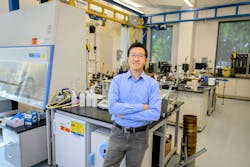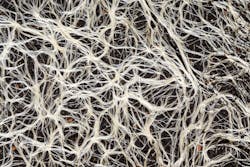How Mud Dauber Wasps Inspired 3D-Printed Homes
A few years ago, Hai “Thomas” Lin was watching mud dauber wasps build nests on his newly purchased home. An assistant professor of civil and environmental engineering at Louisiana State University (LSU), Lin worked on soil improvement—and he was fascinated by the mud daubers’ expert manipulation of dirt.
“I had an inspiration,” Lin recalls. “I wondered, Why do mud daubers build those nests, and what are the properties of those nests?”
Lin soon learned that “mud daubers are actually expert soil nest builders,” he says. Lin found that mud daubers carefully select the best type of soil for their nests. They manage the soil’s moisture content to make it easier to work with. They tap the soil repeatedly with their front legs and jaws to compact the soil, and they use air to harden it.
Lin also learned that the mud daubers don’t build conventional, solid walls in the way we think of them. Instead, they build clusters of tube-like cells—which makes their nests both very light and very strong. Also: “It’s more material efficient,” Lin says.
With the mud dauber as his inspiration, Lin now aims to design earthen homes made of 3D-printed soil.
3D-Printing Homes With Soil
The advantage of using soil as the material for an extrusion 3D printer, Lin explains, is that it’s a natural material that can be locally sourced—reducing costs. Soil also can absorb harmful chemicals in the air and control the air’s moisture content. Plus, it’s excellent insulation material.
Soil alone isn’t enough to create a sturdy structure, however. Lin has determined that a fungal mycelial mixture, when added to the soil, can work as a binder and lead to optimal 3D printability. During and after printing, the fungal mycelium reinforces the soil structure, making it stronger.
“I rely on fungal mycelium to strengthen the soil instead of conventional binders like cement, which is energy intensive,” Lin says. “The fungal mycelium serves as a natural glue and water repellent, and it improves the erosion resistance of the printed soil structure.”
RELATED
- How AI and Mushrooms Helped Turn an Empty Urban Lot into Affordable Housing
- Sustainable Housing: Growing Homes From Fungi
- 3D Printed Homes Project Tracker
Like the mud daubers, Lin doesn’t plan to print rectangular walls. “Instead, I plan to print tubular multi-cell elements and assemble them to build a wall structure.” This modular construction will help increase the efficiency of soil use.
Lin hopes his earthen homes can help address the affordable housing crisis. With locally sourced material like soil, the technology can reduce construction costs, while 3D printing can help reduce labor costs. The ultimate objective is to create earthen buildings that are sustainable, durable, and cost effective.
“Historically speaking, earthen buildings are an old technique,” Lin says. “My goal is to modernize this old technique.”
An estimated 650 to 700 million people live in earthen dwellings today. But dismiss any notion of earthen buildings as messy clumps of mud—or as human-size mud dauber nests. Earthen homes can be as sophisticated and stylish as any contemporary, eco-friendly structure, Lin says.
Earthen dwellings also have myriad benefits, Lin says: natural insulation, excellent indoor air quality, low embodied energy, and a significantly reduced environmental impact. They’re waterproof and fire resistant, as well as recyclable.
Figuring out the technology isn’t the biggest hurdle to developing and scaling 3D-printed earthen buildings, Lin says. “The main challenge is the general public’s perceptions of earthen buildings as historically associated with poverty or under-development,” he says. “Many people are unfamiliar with the modern advancements in earth construction techniques.” Today’s earthen buildings have better durability and resilience than their predecessors, Lin says.
Building codes also present a challenge, he says. “They are often designed with conventional materials in mind, which makes it more difficult and expensive to get approval for earthen buildings.”
Overcoming such perceptions will take education and awareness, as well as feasibility projects like Lin’s.
For now, “the technology is still at the initial stage,” Lin says. A recently announced award of almost $630,000 from the National Science Foundation will support Lin’s research and teaching for the next five to 10 years, as he and his LSU students study the soil mixture and fungal treatment.
Lin hopes to construct a section of wall using his technology next year—and then 3D print a one-story earthen home in Louisiana by 2029 or 2030.


